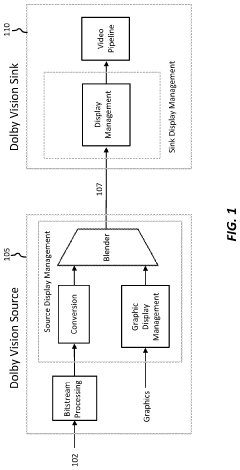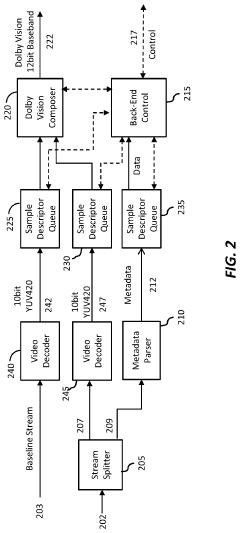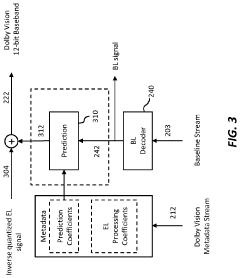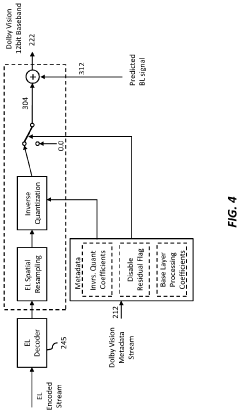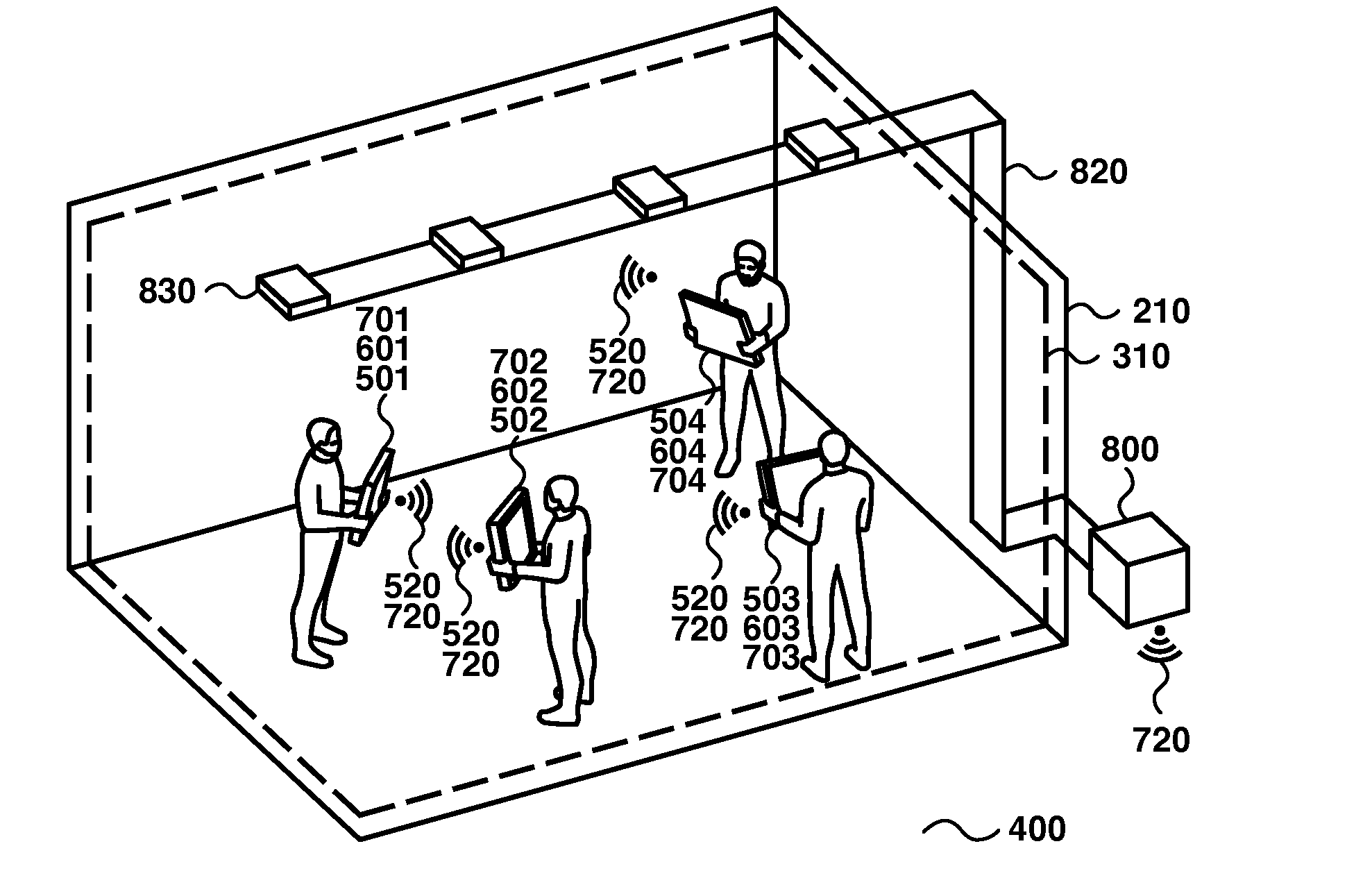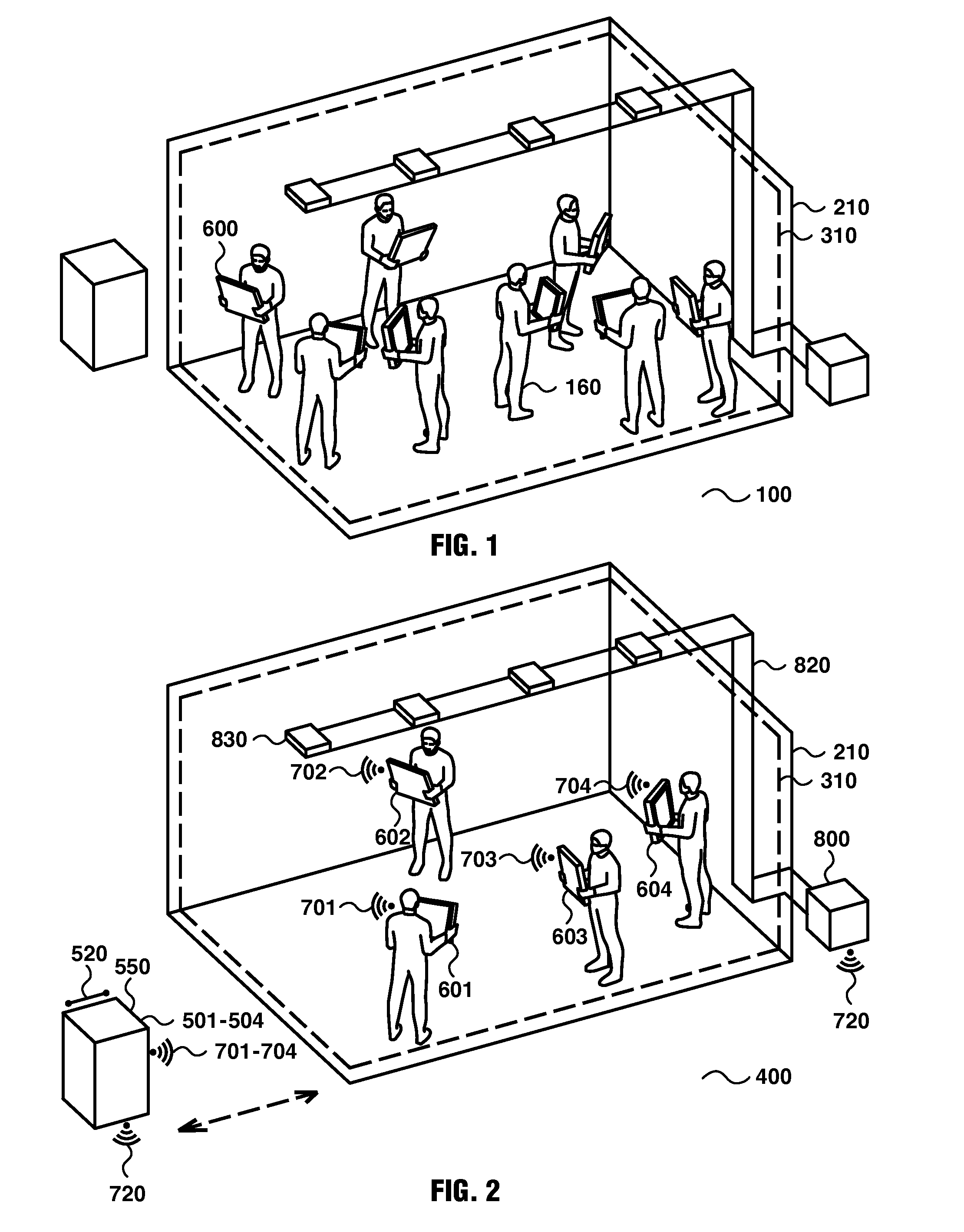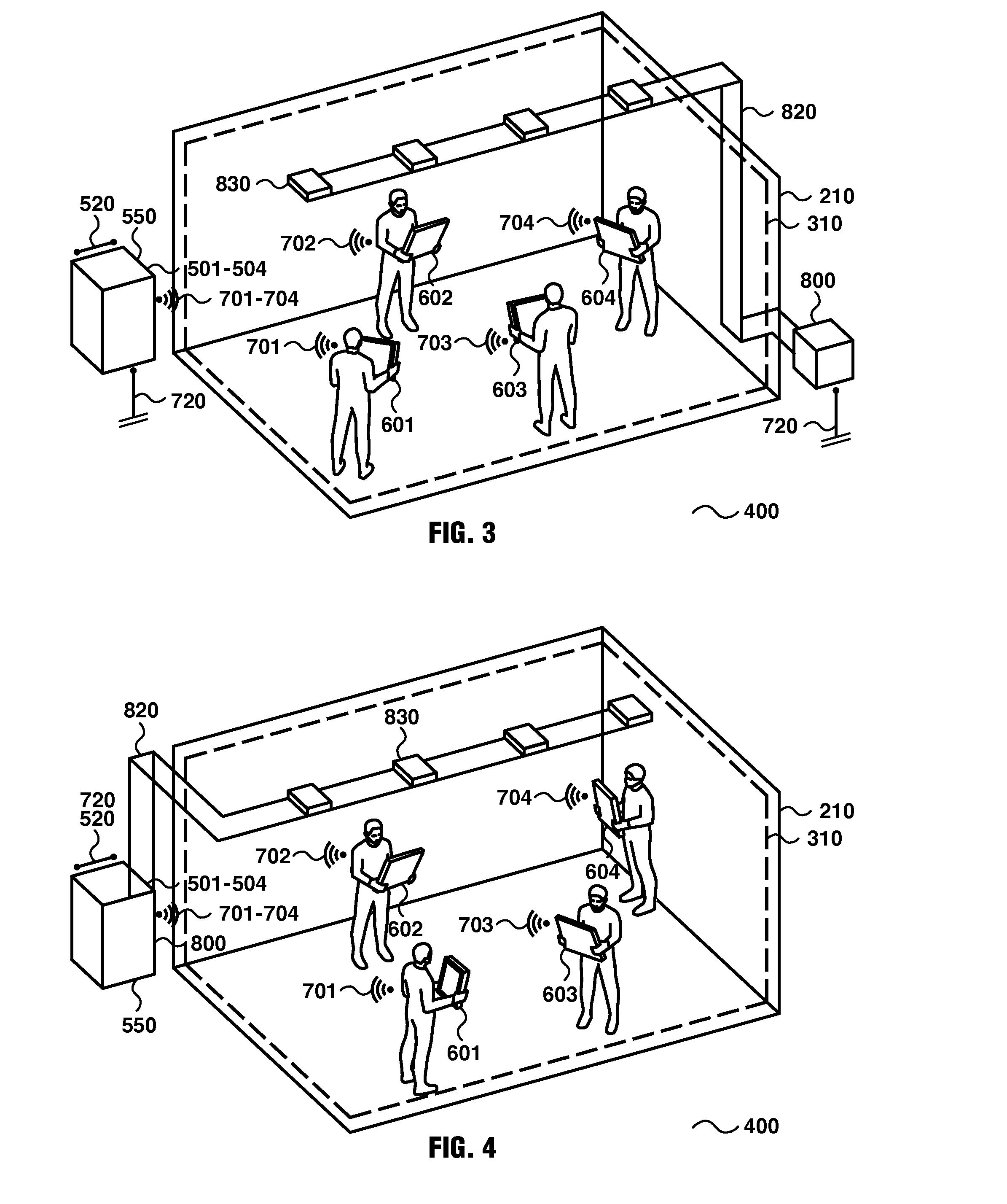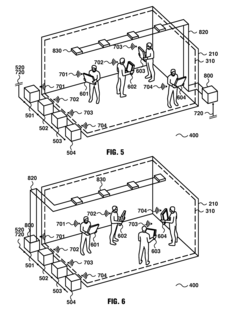Impact of Dolby Vision on Multi-user Interactive Experiences
JUL 30, 20259 MIN READ
Generate Your Research Report Instantly with AI Agent
Patsnap Eureka helps you evaluate technical feasibility & market potential.
Dolby Vision Evolution and Objectives
Dolby Vision, introduced in 2014, has revolutionized the visual experience in digital content consumption. This high dynamic range (HDR) imaging technology has evolved significantly over the years, aiming to deliver superior picture quality across various devices and platforms. The primary objective of Dolby Vision has been to enhance the viewer's experience by providing more vibrant colors, deeper blacks, and brighter highlights, ultimately creating a more immersive and lifelike visual experience.
The evolution of Dolby Vision can be traced through several key milestones. Initially focused on cinema applications, it quickly expanded to home entertainment systems, including televisions and streaming devices. As the technology matured, Dolby Vision adapted to mobile devices, bringing professional-grade color grading to smartphones and tablets. This expansion across different platforms demonstrates Dolby Vision's versatility and its goal of providing consistent, high-quality visuals across all viewing environments.
In recent years, Dolby Vision has set its sights on emerging technologies and interactive experiences. The integration of Dolby Vision into gaming consoles and PCs marks a significant step towards enhancing the visual fidelity of interactive content. This move aligns with the growing demand for more immersive and realistic gaming experiences, showcasing Dolby Vision's adaptability to different forms of media consumption.
The objectives of Dolby Vision have expanded beyond simply improving picture quality. As multi-user interactive experiences gain prominence, Dolby Vision aims to address the unique challenges presented by shared viewing environments. These objectives include maintaining consistent color accuracy and contrast across different viewing angles, adapting to varying ambient light conditions, and ensuring that the visual experience remains optimal for multiple viewers simultaneously.
Furthermore, Dolby Vision is exploring ways to enhance collaborative and social experiences in digital environments. This includes developing technologies that can dynamically adjust visual parameters based on the number of users and their positions, ensuring that each participant receives an optimal viewing experience. The goal is to create a more inclusive and engaging visual environment that can adapt to diverse user scenarios, from gaming to virtual meetings and beyond.
As Dolby Vision continues to evolve, its objectives are increasingly aligned with the broader trends in digital interaction and immersive technologies. The focus is shifting towards creating more personalized and adaptive visual experiences that can seamlessly integrate with various forms of content and user interactions. This evolution positions Dolby Vision not just as a video technology, but as a key component in shaping the future of multi-user interactive digital experiences.
The evolution of Dolby Vision can be traced through several key milestones. Initially focused on cinema applications, it quickly expanded to home entertainment systems, including televisions and streaming devices. As the technology matured, Dolby Vision adapted to mobile devices, bringing professional-grade color grading to smartphones and tablets. This expansion across different platforms demonstrates Dolby Vision's versatility and its goal of providing consistent, high-quality visuals across all viewing environments.
In recent years, Dolby Vision has set its sights on emerging technologies and interactive experiences. The integration of Dolby Vision into gaming consoles and PCs marks a significant step towards enhancing the visual fidelity of interactive content. This move aligns with the growing demand for more immersive and realistic gaming experiences, showcasing Dolby Vision's adaptability to different forms of media consumption.
The objectives of Dolby Vision have expanded beyond simply improving picture quality. As multi-user interactive experiences gain prominence, Dolby Vision aims to address the unique challenges presented by shared viewing environments. These objectives include maintaining consistent color accuracy and contrast across different viewing angles, adapting to varying ambient light conditions, and ensuring that the visual experience remains optimal for multiple viewers simultaneously.
Furthermore, Dolby Vision is exploring ways to enhance collaborative and social experiences in digital environments. This includes developing technologies that can dynamically adjust visual parameters based on the number of users and their positions, ensuring that each participant receives an optimal viewing experience. The goal is to create a more inclusive and engaging visual environment that can adapt to diverse user scenarios, from gaming to virtual meetings and beyond.
As Dolby Vision continues to evolve, its objectives are increasingly aligned with the broader trends in digital interaction and immersive technologies. The focus is shifting towards creating more personalized and adaptive visual experiences that can seamlessly integrate with various forms of content and user interactions. This evolution positions Dolby Vision not just as a video technology, but as a key component in shaping the future of multi-user interactive digital experiences.
Multi-user Experience Market Analysis
The multi-user experience market has witnessed significant growth in recent years, driven by advancements in display technologies and interactive platforms. Dolby Vision, with its enhanced dynamic range and color capabilities, is poised to revolutionize this sector by offering more immersive and engaging shared experiences.
The global multi-user experience market, encompassing areas such as collaborative gaming, virtual reality environments, and interactive entertainment venues, has been expanding rapidly. This growth is fueled by increasing demand for social connectivity and shared digital experiences, particularly in the wake of global events that have accelerated the adoption of remote interaction technologies.
In the gaming sector, which represents a substantial portion of the multi-user experience market, the introduction of Dolby Vision has the potential to dramatically enhance visual fidelity and user engagement. The technology's ability to deliver more vibrant colors and improved contrast ratios aligns well with the industry's push towards more realistic and immersive gaming environments.
The entertainment and media industry is another key area where Dolby Vision's impact on multi-user experiences is expected to be significant. Theme parks, interactive museums, and digital art installations are increasingly incorporating high-fidelity visual technologies to create shared spectacles. Dolby Vision's superior image quality can elevate these experiences, potentially driving increased footfall and customer satisfaction.
Corporate and educational sectors also present growth opportunities for Dolby Vision-enhanced multi-user experiences. As remote collaboration becomes more prevalent, there is a growing need for high-quality visual communication tools. Dolby Vision's ability to render lifelike images can improve the effectiveness of virtual meetings, training sessions, and collaborative design processes.
The market analysis indicates that consumer expectations for visual quality in shared digital experiences are rising. This trend is likely to accelerate the adoption of technologies like Dolby Vision across various platforms and devices. However, the market also faces challenges, including the need for compatible hardware and content, which may initially limit widespread adoption.
As the technology matures and becomes more accessible, we can expect to see a proliferation of Dolby Vision-enabled multi-user experiences across different sectors. This expansion is likely to create new opportunities for content creators, hardware manufacturers, and service providers in the multi-user experience ecosystem.
The global multi-user experience market, encompassing areas such as collaborative gaming, virtual reality environments, and interactive entertainment venues, has been expanding rapidly. This growth is fueled by increasing demand for social connectivity and shared digital experiences, particularly in the wake of global events that have accelerated the adoption of remote interaction technologies.
In the gaming sector, which represents a substantial portion of the multi-user experience market, the introduction of Dolby Vision has the potential to dramatically enhance visual fidelity and user engagement. The technology's ability to deliver more vibrant colors and improved contrast ratios aligns well with the industry's push towards more realistic and immersive gaming environments.
The entertainment and media industry is another key area where Dolby Vision's impact on multi-user experiences is expected to be significant. Theme parks, interactive museums, and digital art installations are increasingly incorporating high-fidelity visual technologies to create shared spectacles. Dolby Vision's superior image quality can elevate these experiences, potentially driving increased footfall and customer satisfaction.
Corporate and educational sectors also present growth opportunities for Dolby Vision-enhanced multi-user experiences. As remote collaboration becomes more prevalent, there is a growing need for high-quality visual communication tools. Dolby Vision's ability to render lifelike images can improve the effectiveness of virtual meetings, training sessions, and collaborative design processes.
The market analysis indicates that consumer expectations for visual quality in shared digital experiences are rising. This trend is likely to accelerate the adoption of technologies like Dolby Vision across various platforms and devices. However, the market also faces challenges, including the need for compatible hardware and content, which may initially limit widespread adoption.
As the technology matures and becomes more accessible, we can expect to see a proliferation of Dolby Vision-enabled multi-user experiences across different sectors. This expansion is likely to create new opportunities for content creators, hardware manufacturers, and service providers in the multi-user experience ecosystem.
Dolby Vision Technical Challenges
Dolby Vision, as a cutting-edge HDR technology, presents several technical challenges when applied to multi-user interactive experiences. One of the primary obstacles is the need for consistent color and brightness reproduction across various devices and viewing environments. This becomes particularly complex in multi-user scenarios where each participant may be using different display technologies or viewing content under diverse lighting conditions.
Another significant challenge lies in the real-time processing and rendering of Dolby Vision content for interactive applications. The high dynamic range and wide color gamut of Dolby Vision require substantial computational resources, which can introduce latency in interactive experiences. This becomes especially critical in fast-paced, multi-user environments where even slight delays can significantly impact user engagement and performance.
The bandwidth requirements for streaming Dolby Vision content also pose a challenge in multi-user settings. The increased data volume associated with HDR content can strain network infrastructure, potentially leading to buffering issues or reduced quality, particularly in scenarios with multiple simultaneous users.
Ensuring backward compatibility with non-Dolby Vision displays while maintaining the enhanced visual experience for Dolby Vision-enabled devices is another technical hurdle. This requires sophisticated content adaptation algorithms that can dynamically adjust the visual output based on the capabilities of each user's display device.
The challenge of color management across different user environments is particularly complex. Dolby Vision's expanded color space may not be consistently reproducible across all devices, leading to potential discrepancies in how different users perceive the same content. This can be especially problematic in collaborative or competitive multi-user scenarios where color accuracy is crucial.
Additionally, the implementation of Dolby Vision in virtual or augmented reality environments for multi-user experiences introduces unique challenges. These include managing the increased computational load of rendering high-quality HDR content in real-time 3D environments and ensuring consistent visual experiences across different VR/AR hardware platforms.
Lastly, the integration of Dolby Vision with existing multi-user platforms and content delivery systems presents technical challenges. This includes adapting current workflows and infrastructure to support the enhanced metadata and processing requirements of Dolby Vision, while maintaining compatibility with legacy systems and ensuring seamless user experiences across different devices and platforms.
Another significant challenge lies in the real-time processing and rendering of Dolby Vision content for interactive applications. The high dynamic range and wide color gamut of Dolby Vision require substantial computational resources, which can introduce latency in interactive experiences. This becomes especially critical in fast-paced, multi-user environments where even slight delays can significantly impact user engagement and performance.
The bandwidth requirements for streaming Dolby Vision content also pose a challenge in multi-user settings. The increased data volume associated with HDR content can strain network infrastructure, potentially leading to buffering issues or reduced quality, particularly in scenarios with multiple simultaneous users.
Ensuring backward compatibility with non-Dolby Vision displays while maintaining the enhanced visual experience for Dolby Vision-enabled devices is another technical hurdle. This requires sophisticated content adaptation algorithms that can dynamically adjust the visual output based on the capabilities of each user's display device.
The challenge of color management across different user environments is particularly complex. Dolby Vision's expanded color space may not be consistently reproducible across all devices, leading to potential discrepancies in how different users perceive the same content. This can be especially problematic in collaborative or competitive multi-user scenarios where color accuracy is crucial.
Additionally, the implementation of Dolby Vision in virtual or augmented reality environments for multi-user experiences introduces unique challenges. These include managing the increased computational load of rendering high-quality HDR content in real-time 3D environments and ensuring consistent visual experiences across different VR/AR hardware platforms.
Lastly, the integration of Dolby Vision with existing multi-user platforms and content delivery systems presents technical challenges. This includes adapting current workflows and infrastructure to support the enhanced metadata and processing requirements of Dolby Vision, while maintaining compatibility with legacy systems and ensuring seamless user experiences across different devices and platforms.
Current Dolby Vision Integration Solutions
01 Interactive video playback and control
Dolby Vision interactive experiences involve systems and methods for interactive video playback and control. This includes features like user-controlled navigation through video content, interactive elements overlaid on video, and dynamic adjustments to playback based on user inputs. These technologies enhance viewer engagement and provide a more immersive entertainment experience.- Enhanced visual experience with Dolby Vision: Dolby Vision technology is used to create interactive experiences with enhanced visual quality. This includes improved color, contrast, and brightness in displays, providing a more immersive and realistic viewing experience for users across various devices and platforms.
- Interactive user interfaces for Dolby Vision content: Development of interactive user interfaces specifically designed for Dolby Vision content, allowing users to manipulate and interact with high-dynamic-range (HDR) video in real-time. These interfaces may include controls for adjusting visual parameters and exploring different aspects of the enhanced content.
- Integration of Dolby Vision in gaming and virtual reality: Incorporation of Dolby Vision technology into gaming and virtual reality applications to create more immersive and visually stunning interactive experiences. This includes enhanced graphics rendering, realistic lighting effects, and improved depth perception in virtual environments.
- Adaptive streaming and content delivery for Dolby Vision: Implementation of adaptive streaming technologies and content delivery systems optimized for Dolby Vision, ensuring high-quality interactive experiences across various network conditions and devices. This includes dynamic adjustment of video quality and efficient compression techniques for HDR content.
- Dolby Vision-enabled devices and display calibration: Development of devices and display technologies specifically designed to support Dolby Vision interactive experiences. This includes automatic calibration systems to ensure optimal visual quality across different viewing environments and display types, as well as integration with various consumer electronics.
02 Enhanced visual quality and display technologies
Dolby Vision incorporates advanced display technologies to improve visual quality in interactive experiences. This includes high dynamic range (HDR) imaging, wide color gamut, and enhanced contrast ratios. These technologies work together to provide more vibrant, lifelike images and improve the overall visual experience for users interacting with Dolby Vision content.Expand Specific Solutions03 Personalized content delivery and user experience
Interactive experiences in Dolby Vision can be tailored to individual users through personalized content delivery systems. This includes adaptive streaming technologies, user preference learning, and dynamic content recommendations. These features allow for a more engaging and customized viewing experience based on user behavior and preferences.Expand Specific Solutions04 Multi-device synchronization and interaction
Dolby Vision interactive experiences can extend across multiple devices, allowing for synchronized playback and interaction. This includes second-screen applications, device-to-device content sharing, and collaborative viewing experiences. These technologies enable users to engage with content across various platforms while maintaining a cohesive and immersive experience.Expand Specific Solutions05 Audio enhancement and integration
Interactive experiences in Dolby Vision also incorporate advanced audio technologies to complement the visual enhancements. This includes object-based audio, spatial sound, and interactive audio elements that respond to user actions. These audio features work in tandem with the visual components to create a more immersive and engaging overall experience.Expand Specific Solutions
Key Industry Players and Partnerships
The impact of Dolby Vision on multi-user interactive experiences is shaping a competitive landscape in an emerging market with significant growth potential. The technology is still in its early stages of adoption, with major players like Apple, Sony, and Samsung leading development efforts. As the market matures, we're seeing increased interest from content providers like Disney and technology companies such as Huawei and Tencent. The integration of Dolby Vision into interactive platforms is driving innovation in areas like gaming, virtual reality, and streaming services, with companies like Nintendo, Roku, and Microsoft exploring applications. As the technology evolves, we can expect to see more diverse implementations across various consumer electronics and entertainment sectors.
Apple, Inc.
Technical Solution: Apple has integrated Dolby Vision into its ecosystem, enhancing multi-user interactive experiences across devices. Their approach leverages the high dynamic range (HDR) capabilities of Dolby Vision to deliver more immersive and realistic visuals in gaming and collaborative applications. Apple's implementation includes real-time HDR rendering for interactive content, allowing multiple users to experience consistent, high-quality visuals regardless of their device's display capabilities[1]. The company has also developed algorithms for dynamic tone mapping that adapt to varying ambient lighting conditions, ensuring optimal viewing experiences in different environments[3].
Strengths: Seamless integration across Apple ecosystem, optimized for various devices. Weaknesses: Limited to Apple hardware, potentially excluding non-Apple users from full experience.
Sony Interactive Entertainment LLC
Technical Solution: Sony has implemented Dolby Vision in its PlayStation platform, focusing on enhancing multi-user gaming experiences. Their approach includes dynamic HDR optimization for each frame, ensuring that multiple players see the same high-quality visuals regardless of their individual display setups. Sony has also developed a proprietary technology that combines Dolby Vision with 3D audio to create more immersive interactive environments[2]. This integration extends to virtual reality applications, where Dolby Vision is used to improve depth perception and color accuracy in multi-user VR spaces[4].
Strengths: Strong integration with gaming and VR platforms, enhancing immersion. Weaknesses: May require specific hardware for full feature set, potentially limiting accessibility.
Core Dolby Vision Technologies
Layered representation and delivery of high dynamic range video
PatentActiveUS20190373290A1
Innovation
- The implementation of a layered representation and delivery system for HDR video, utilizing Dolby Vision technology, which includes a base layer and enhancement layer, along with metadata processing to reconstruct HDR signals, ensuring seamless playback on compatible displays.
Multi-user virtual reality interaction environment
PatentInactiveUS20150193979A1
Innovation
- A system comprising portable interactive devices with trackers, display modules, and input modules, connected to computing devices and tracking servers, allows for the generation and transmission of views of shared virtual spaces, enabling manual movement and input signals to control virtual cameras and interact with detailed virtual objects, ensuring all users see the same virtual space superimposed on the physical space.
Content Creation and Distribution
Dolby Vision's impact on content creation and distribution for multi-user interactive experiences has been transformative, pushing the boundaries of visual quality and immersion. This technology has necessitated significant changes in production workflows, requiring content creators to adapt their processes to capture and preserve the enhanced dynamic range and color depth that Dolby Vision offers.
In the realm of content creation, cinematographers and visual effects artists now have access to a broader palette of colors and luminance levels. This expanded creative space allows for more nuanced and realistic representations of scenes, particularly in high-contrast environments. However, it also demands a higher level of precision in lighting, color grading, and post-production processes to fully leverage Dolby Vision's capabilities.
The adoption of Dolby Vision has led to the development of new tools and software solutions specifically designed to handle high dynamic range (HDR) content. These tools enable creators to visualize and manipulate the expanded color and brightness ranges in real-time, ensuring that the final product maintains its intended visual impact across various display devices.
From a distribution perspective, Dolby Vision has introduced new challenges and opportunities. The increased data requirements for Dolby Vision content have necessitated advancements in compression technologies and streaming protocols. Content delivery networks (CDNs) have had to optimize their infrastructure to handle the larger file sizes and bandwidth demands associated with HDR content.
Streaming platforms and broadcasters have been at the forefront of adopting Dolby Vision, recognizing its potential to enhance viewer engagement. This has led to a growing catalog of Dolby Vision-enabled content, ranging from movies and TV series to live sports events. However, the rollout has been gradual, as it requires compatible hardware on the consumer end.
For multi-user interactive experiences, such as gaming and virtual reality, Dolby Vision presents unique opportunities and challenges. Game developers are exploring ways to integrate Dolby Vision's enhanced visual fidelity into their titles, potentially revolutionizing the gaming experience. This includes not only improving the overall visual quality but also using the expanded dynamic range to enhance gameplay elements, such as more realistic lighting in dark environments or more impactful special effects.
The implementation of Dolby Vision in multi-user scenarios also raises considerations about bandwidth and latency, particularly for cloud gaming services. Ensuring a consistent and high-quality Dolby Vision experience across multiple users with varying network conditions and display capabilities remains an ongoing challenge for content distributors and service providers.
In the realm of content creation, cinematographers and visual effects artists now have access to a broader palette of colors and luminance levels. This expanded creative space allows for more nuanced and realistic representations of scenes, particularly in high-contrast environments. However, it also demands a higher level of precision in lighting, color grading, and post-production processes to fully leverage Dolby Vision's capabilities.
The adoption of Dolby Vision has led to the development of new tools and software solutions specifically designed to handle high dynamic range (HDR) content. These tools enable creators to visualize and manipulate the expanded color and brightness ranges in real-time, ensuring that the final product maintains its intended visual impact across various display devices.
From a distribution perspective, Dolby Vision has introduced new challenges and opportunities. The increased data requirements for Dolby Vision content have necessitated advancements in compression technologies and streaming protocols. Content delivery networks (CDNs) have had to optimize their infrastructure to handle the larger file sizes and bandwidth demands associated with HDR content.
Streaming platforms and broadcasters have been at the forefront of adopting Dolby Vision, recognizing its potential to enhance viewer engagement. This has led to a growing catalog of Dolby Vision-enabled content, ranging from movies and TV series to live sports events. However, the rollout has been gradual, as it requires compatible hardware on the consumer end.
For multi-user interactive experiences, such as gaming and virtual reality, Dolby Vision presents unique opportunities and challenges. Game developers are exploring ways to integrate Dolby Vision's enhanced visual fidelity into their titles, potentially revolutionizing the gaming experience. This includes not only improving the overall visual quality but also using the expanded dynamic range to enhance gameplay elements, such as more realistic lighting in dark environments or more impactful special effects.
The implementation of Dolby Vision in multi-user scenarios also raises considerations about bandwidth and latency, particularly for cloud gaming services. Ensuring a consistent and high-quality Dolby Vision experience across multiple users with varying network conditions and display capabilities remains an ongoing challenge for content distributors and service providers.
User Experience and Accessibility
Dolby Vision's impact on multi-user interactive experiences has significantly enhanced user experience and accessibility. The technology's advanced HDR capabilities have revolutionized visual quality, providing a more immersive and engaging environment for multiple users simultaneously.
The improved contrast ratio and wider color gamut offered by Dolby Vision contribute to a more realistic and vibrant visual experience. This is particularly beneficial in multi-user scenarios, where each participant can enjoy enhanced image quality regardless of their viewing position or angle. The technology's ability to optimize content on a scene-by-scene basis ensures consistent visual fidelity across various devices and screens, promoting a uniform experience for all users.
Accessibility has been greatly improved through Dolby Vision's enhanced dynamic range. The technology's ability to display a broader spectrum of brightness levels allows for better visibility in both dark and bright scenes. This is especially advantageous for users with visual impairments, as it can help distinguish details that might otherwise be lost in standard dynamic range displays.
In interactive environments, such as gaming or collaborative virtual spaces, Dolby Vision's impact is particularly noteworthy. The technology's low latency and frame-by-frame metadata processing enable smooth and responsive visuals, crucial for maintaining user engagement and reducing eye strain during extended sessions. This is especially important in multi-user scenarios where synchronization and visual consistency are paramount.
The technology also addresses the challenge of varying ambient lighting conditions in multi-user setups. Dolby Vision's adaptive optimization ensures that content remains visually appealing and easily discernible across different viewing environments, from brightly lit rooms to dimly lit spaces. This adaptability enhances accessibility for users with different visual needs or preferences.
Furthermore, Dolby Vision's compatibility with a wide range of devices and platforms contributes to its accessibility. Users can enjoy enhanced visual experiences across various screens, from large-format displays to mobile devices, ensuring continuity and consistency in multi-user interactive scenarios.
The technology's impact extends beyond visual enhancements, influencing the overall design and implementation of interactive experiences. Developers and content creators can leverage Dolby Vision to craft more nuanced and visually rich environments, potentially leading to new forms of interaction and collaboration in multi-user settings.
The improved contrast ratio and wider color gamut offered by Dolby Vision contribute to a more realistic and vibrant visual experience. This is particularly beneficial in multi-user scenarios, where each participant can enjoy enhanced image quality regardless of their viewing position or angle. The technology's ability to optimize content on a scene-by-scene basis ensures consistent visual fidelity across various devices and screens, promoting a uniform experience for all users.
Accessibility has been greatly improved through Dolby Vision's enhanced dynamic range. The technology's ability to display a broader spectrum of brightness levels allows for better visibility in both dark and bright scenes. This is especially advantageous for users with visual impairments, as it can help distinguish details that might otherwise be lost in standard dynamic range displays.
In interactive environments, such as gaming or collaborative virtual spaces, Dolby Vision's impact is particularly noteworthy. The technology's low latency and frame-by-frame metadata processing enable smooth and responsive visuals, crucial for maintaining user engagement and reducing eye strain during extended sessions. This is especially important in multi-user scenarios where synchronization and visual consistency are paramount.
The technology also addresses the challenge of varying ambient lighting conditions in multi-user setups. Dolby Vision's adaptive optimization ensures that content remains visually appealing and easily discernible across different viewing environments, from brightly lit rooms to dimly lit spaces. This adaptability enhances accessibility for users with different visual needs or preferences.
Furthermore, Dolby Vision's compatibility with a wide range of devices and platforms contributes to its accessibility. Users can enjoy enhanced visual experiences across various screens, from large-format displays to mobile devices, ensuring continuity and consistency in multi-user interactive scenarios.
The technology's impact extends beyond visual enhancements, influencing the overall design and implementation of interactive experiences. Developers and content creators can leverage Dolby Vision to craft more nuanced and visually rich environments, potentially leading to new forms of interaction and collaboration in multi-user settings.
Unlock deeper insights with Patsnap Eureka Quick Research — get a full tech report to explore trends and direct your research. Try now!
Generate Your Research Report Instantly with AI Agent
Supercharge your innovation with Patsnap Eureka AI Agent Platform!
